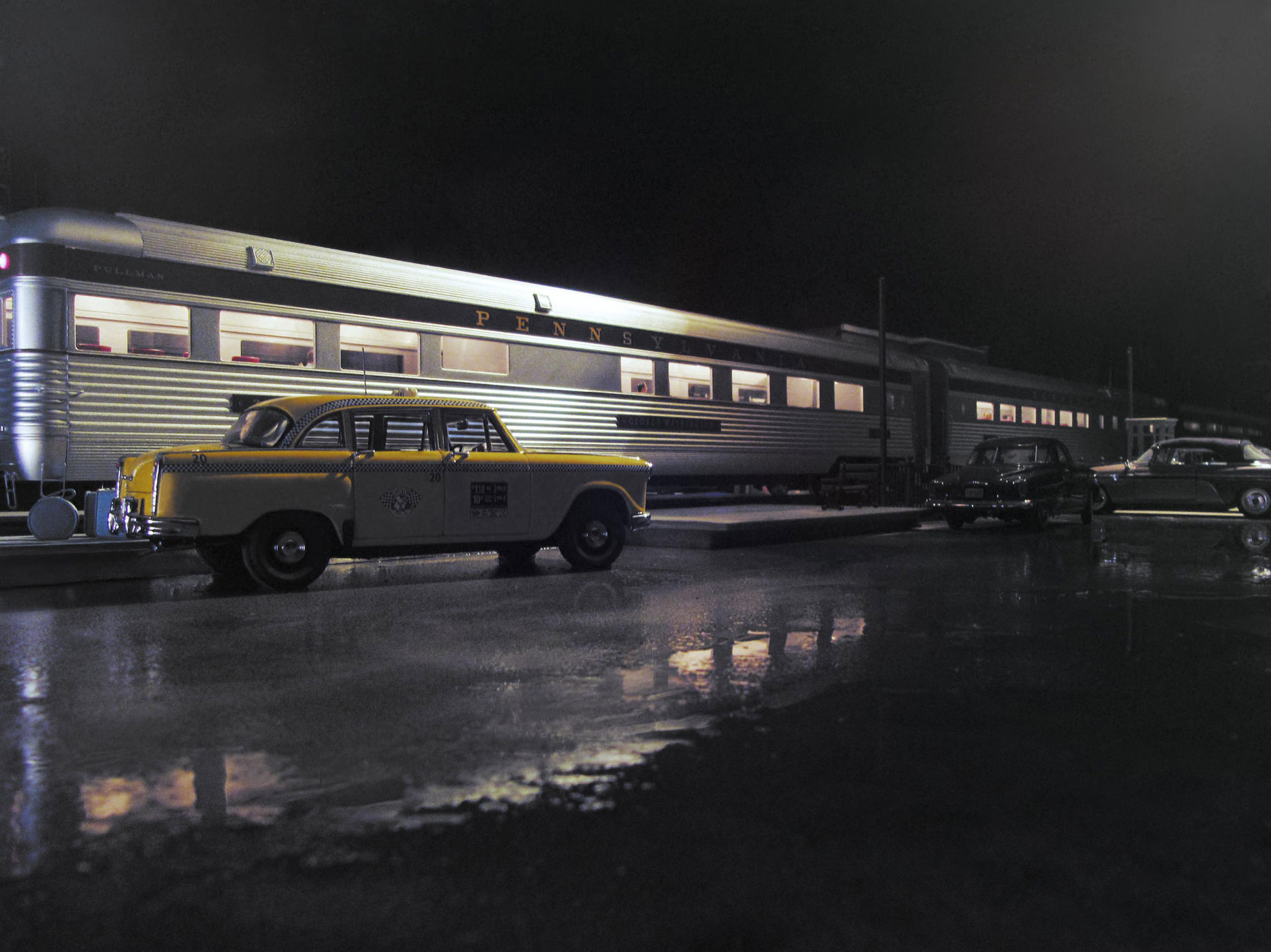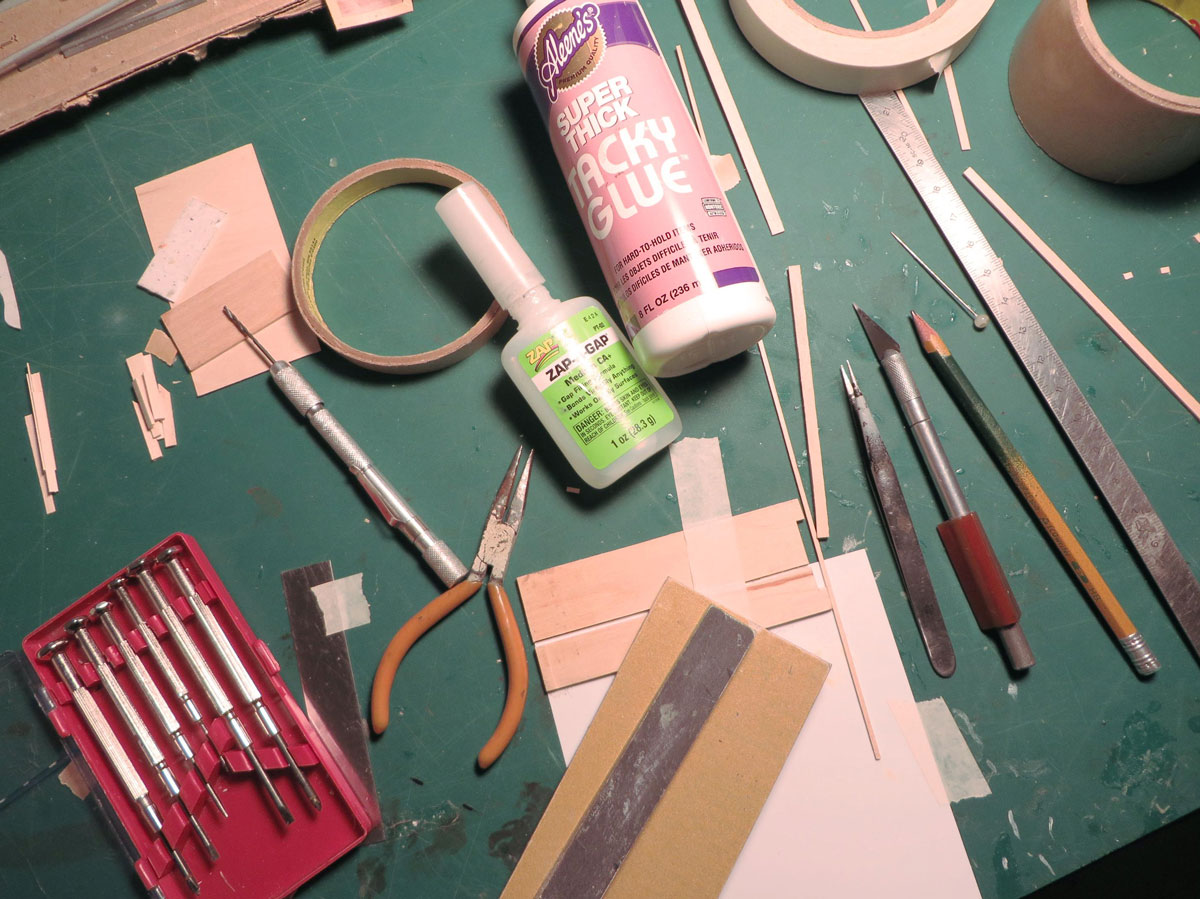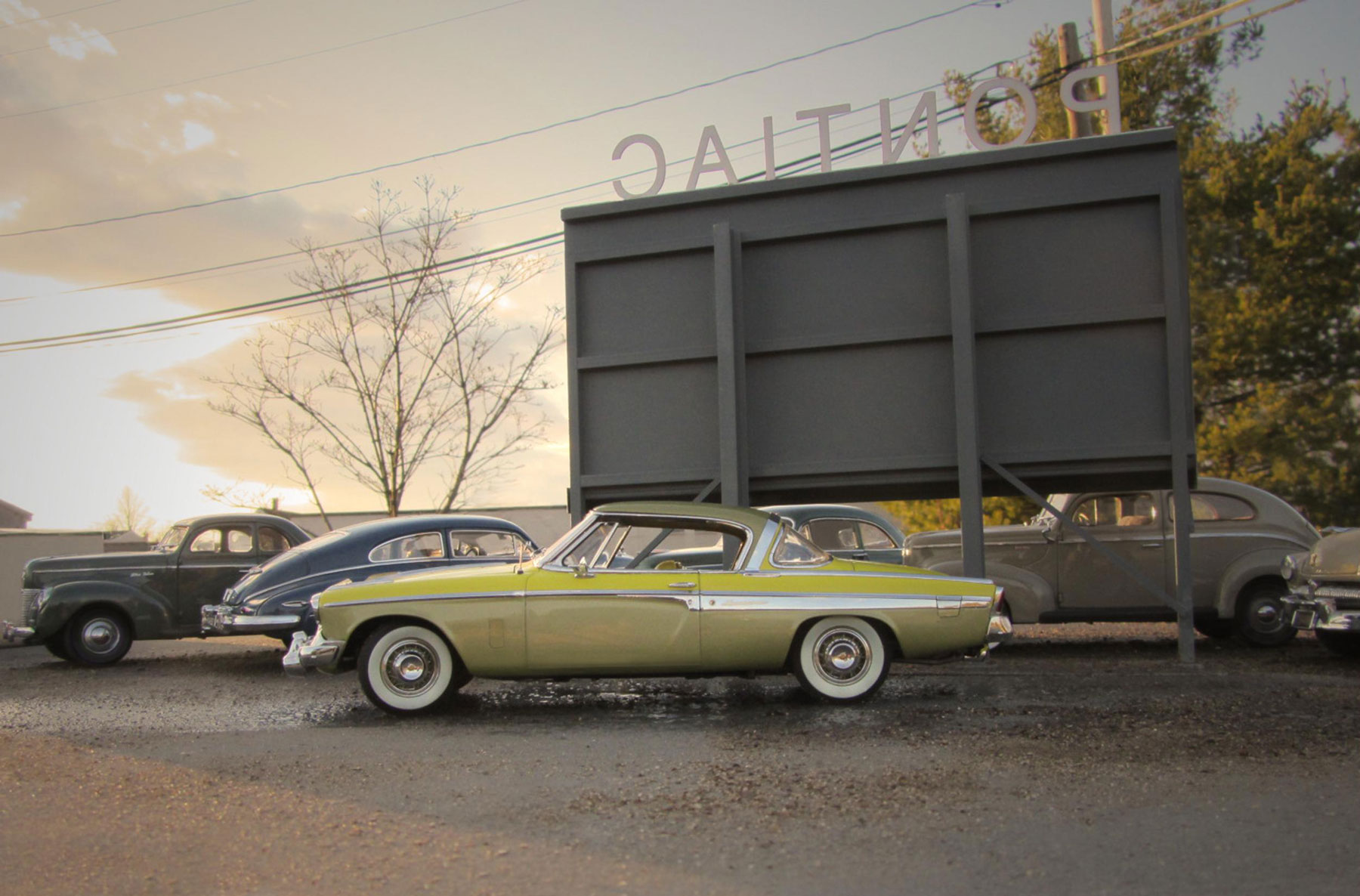

Last Taxi to the Station, 11x14in, Digital Print, 2010
I was born in the steel mill town of Pittsburgh, PA in 1950. I was one of five children in a working class family. My childhood was pleasant and loving, but due to my extreme shyness, I kept to myself and used my imagination to build and draw things.
I have been making models since I was in grade school. Literally, I would take cigar boxes and create interiors out of found objects. There was a great sense of satisfaction in doing this. Miniatures, dollhouses, dioramas, train layouts and the like have always had a mesmerizing effect on me.
When I was in high school, my guidance counselor said I had no apparent creative talent that could be used for employment, so I should consider just graduating and going directly to work in the steel mills. Well, I didn’t take that advice to heart.
I’ve had many diverse occupations. I was an art director in advertising, which gave me a heart attack at 33 – clearly a sign to get out of that profession. At that point, it occurred to me I wanted to be a model-maker. Without any hesitation, I set up interviews with all of the local model shops in the Boston area. One small company said they would let me work for one week to evaluate my skill. At the end of that week, I was hired full-time. The owner didn’t even know my last name when he wrote me my first paycheck.


The Day After It Snowed
11x14in
Digital Print
2013
I have been a wallpaper hanger, an interior house painter, a newspaper editorial artist, a textbook illustrator, and even a mailman at one point. The best job was being a part of a team that designed displays for museums like the Smithsonian Institute and the Museum of Natural History at Harvard. Looking back, all of these professions were what gave me the solid foundation I have for my model-making.
It finally dawned on me that I could build miniature versions of American life…
Flea markets, yard sales and trash picking were ongoing activities since I was 10. I literally had thousands of pieces of the past that took up huge amounts of space. And then there was my Diecast model collecting, which was part of my ongoing interest in the everyday aspects of American 20th century life. It finally dawned on me that I could build miniature versions of American life by creating scaled-down buildings that would incorporate my Diecast vehicles. Plus I could utilize all of the knowledge I had acquired by collecting and studying the 20th century. These scenes could be authentic down to the last detail. It was an “ah-ha!” moment.
The research part of the diorama is the best part for me. I enjoy going through books and catalogs to see what a specific era looked like. I can spend a few days or a week soaking up all of the information. Studying wallpaper samples, paint chips, fabric designs, listening to music of a particular era or going through old photo albums might seem like mindless activities but they lay a concrete foundation for my work. When looking at old photographs, the ones that interest me are the candid snap shots or the ones that capture a time period almost by surprise.


Revisiting the 1963 Corvette StingRay, 11x14in, Digital Print, 2013
The 1948 Chevrolet Fleetline Aerosedan, 11x14in, Digital Print, 2013
Other inspiration comes from looking over my 300-plus Diecast car collection. There are specific design cues throughout each automotive era, the most obvious is the tailfin. But there are other ones like bulbous fenders, swooping rooflines, two-tone color combinations and running boards. It’s these visual cues that get me thinking about the context of those vehicles. Say it’s the running boards of early 20th century automobiles. Cars were relatively new during that era, so that implies there was still a strong Victorian or Edwardian sensibility happening in buildings and society. What would a town look like then? Were the streets paved? Electricity had been introduced into cities but the rural areas were still relying on kerosene lamps. What would that look like? I slowly formulate how a specific scene would encompass all of this information, yet I want the final photograph to look incidental and not staged.
Every structure starts out as a series of rough sketches, which helps me define what the most important features of a structure will be. If the building is too unusual, it will overwhelm the photograph, therefore a prototypical style of a certain era is chosen. Gatorboard, which is a thin film of foam sandwiched between two sheets of resin-coated paper, is the basic building material I use for the walls. It’s lightweight and durable, cuts with a knife and can be sanded and painted easily. Once the basic structure is assembled, it’s just a matter of applying the details such as clapboard, brick, stucco and trim. I realize I’m over-simplifying the process here, but all in all the process is not that complex. I do not have a workshop so my tools are an X-ACTO knife, a sanding block, a ruler and a few other assorted handheld tools.


Model-Making Materials
If you can’t make it convincingly, then don’t make it at all, because it will stick out like a sore thumb.
What’s the secret to making photos of models look real? Keep everything in scale. From the thickness of the shingles down to the wallpaper design and doorknobs, everything must be in the proper balance. Also, keep the camera at the eye level of the imaginary person walking around in the scene. This gives viewers the sense that they are in the picture. Movies have given us newer ways of seeing the world, such as the bird’s eye view or the low-to-the ground angle, so this can sometimes be used in diorama photography. But, it must be used sparingly and for the right reason, otherwise the reality of the shot will be compromised. Our eye is very sensitive to things not looking quite right.
A model-maker I used to work for gave me some sage advice: If you can’t make it convincingly, then don’t make it at all, because it will stick out like a sore thumb. Using snow as an example, I tried many different household products to get the right look- baby powder, talcum powder, flour, salt – none of them felt visually correct. Then I happened upon baking soda and it all came together. There’s a nice sparkle to baking soda, plus it drifts and piles up just like real snow. When it gets wet, it clumps up and sticks to tires and buildings just like the prototype. Exploration is part of the fun, most of the time.


Daphne Ward’s House is For Sale, 11x14in, Digital Print, 2014
Daphne Ward’s House is For Sale – Setup
What has now become a joke, is the fact that I have no special equipment at all. Using strobes, umbrella reflectors and light meters is lost on me. My first camera was a 3 megapixel Sony. I’ve since upgraded to 6 megapixels, and then to a 14 megapixel Canon, because some of my work is being enlarged and printed. It’s a technical thing and not the desire to use something fancy. A dear friend of mine actually gave me an incredibly expensive camera that took extraordinary images. But I found they were too good for what I was trying to accomplish. To achieve a look and feel of the past, I’ve found that a camera, with a lens that blurs, is the way to go. Too much information in a photo defeats the retro look of Elgin Park.
Most of the models are in pieces and stored in boxes because I have no room to display them. But most importantly, I have built them so they can be mixed and matched allowing me to take the front on one building and add it to another, giving the impression there are many different types of structures. It’s very much like a theater stage set. When people do see them, they always say; why aren’t these being protected? Or why aren’t these being displayed to their best advantage? Perhaps, because I know each piece personally, they are less precious and more like old friends who feel comfortable just hanging around. These structures and model cars have been exposed to the outside and also to my experiments of scaled-down snow, rain and fog. I think of them as seasoned actors.


Really, It Looks Worse Than It Was
11x14in
Digital Print
2012
There is really no way for the public to view them. I will immediately contradict myself by saying I once did a small diorama for a museum, which featured a few buildings. It was not the most exciting display because without the proper lighting or being outside with the appropriate backdrop, everything just looks like, well… a model. I do have the Bungalow house model right next to my work desk and above it is a photo of it taken outside. It does take a bit of time to make the connection that they are both the same building. The magic happens in the camera and without the aid of Photoshop. It’s a totally old-school style of special effects.
For an exhibit in New York City, I was asked to create a new piece for the show. I decided to build the house I grew up in when I was young, then drive the 600 miles to Pittsburgh and photograph it in authentic surroundings.


My Childhood Home, 1/24 Scale
11x14in
Digital Print
2011
There were a number of reference photos taken from family picture albums that gave me the necessary information to build it correctly. Let me say here, building your childhood home is the best form of therapy one could hope for. The memories, both good and bad, just start to flow without any safety valves. The project took four months and I felt like I had dealt with a lot of buried psychological issues by the time it was completed.
My photos are a one-frame story being told. Sometimes it is implied by way of having a car door left open, or a single lit storefront with all of the other buildings left dark. These images represent the experiences I’ve had throughout my life. They are a symbolic and shorthand version of living. Yet as personal as they might be to me, there is also room for other people to see their own meaning in the photographs. As I went on, it became clear that I was preserving the past in an odd fashion. Elgin Park never existed, yet here is a visual treasure chest of emotions and memories: a distillation of what had already passed.
Elgin Park never existed, yet here is a visual treasure chest of emotions and memories: a distillation of what had already passed.


Velma Kelley’s 1955 Studebaker Speedster
11x14in
Digital Print
2012
One of the most difficult aspects of creating the Elgin Park experience is keeping an open mind to the potential that is inherent in each scene I’m creating. I try not to second guess, over think or bring preconceived ideas to the photo session. Some of my most successful images were taken when I wasn’t thinking about what I was doing. The 1938 Ford alongside the building is an example, as is the bird’s eye view of the Thunderbird convertible. Both of these were the last shot of the session. What is the saying? Think with your heart, not with your head.
Model-making has taken some serious economic hits over the years, and what used to be a thriving business has now been reduced to freelance nomads. The age of computer-generated graphics, overseas production and automated 3D model-making machines has all but eliminated the field.
I will continue to create my own hand-built structures to keep alive the old School way of doing things. Curiously enough, at this point in time, there is a slowly growing movement away from computer-generated models, not just in architecture, but also in filmmaking and display. To see the hand of man in an object is deeply satisfying. I once worked in a model shop that shared a building with computer companies that created 3D images and drawings. The computer people would frequently visit the shop to watch us make stuff; and they would always say “You guys actually create physical objects with your hands. Amazing!” Humans have always built things. We are a species that uses tools. It is in our DNA. We will never outgrow that aspect of ourselves. And even though what I make are just miniature versions of reality, I am directly influenced by those millions of years of genetics. How cool is that?


1935 – News Happens in Elgin Park, 11x14in, Digital Print, 2012
1935 – News Happens in Elgin Park – Setup